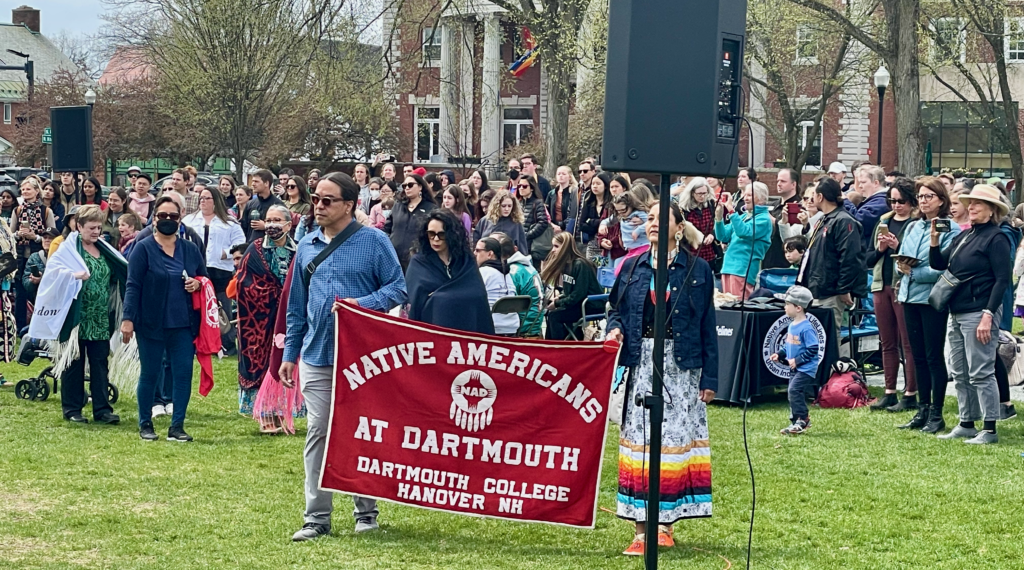
On the afternoon of May 7, the Green proved a breezy and welcoming setting for Dartmouth’s Annual Powwow, an historically prominent gathering of Native Americans—including many Dartmouth alumni—from a multiplicity of tribal nations and communities across the United States. Organized under the auspices of the NAP (Native American Program) as well as the NAD (Native Americans of Dartmouth) student organization, with assistance from the NAAD (Native American Alumni of Dartmouth), this year’s Powwow marked a welcome return for the tradition after a two-year hiatus due to COVID.
The Dartmouth Powwow was inaugurated in 1972 under the stewardship of then-President John Kemeny, who, upon assuming the presidency in 1970, had enduringly recommitted Dartmouth to what he called the “long-deferred promise” of its founding Charter—that is, per the Charter itself, to the education and instruction of youth of the Indian tribes in this land. Thus began under Kemeny a deliberate and successful effort to actively recruit Native American students, an effort which soon expanded Dartmouth’s Native American undergraduate enrollment. This expansion was a welcome change from the College’s dismal record of having graduated only nineteen Native American students over the course of its first 200 years. Since 1970, over 1,200 Native American students, representing more than 200 tribal communities, have received bachelor’s degrees from Dartmouth—more than all the other Ivies combined. Significantly, 5% of the Class of 2025 is Native American.
Alongside his prescribed expansion in recruitment and enrollment, Kemeny introduced the Native American Program and the Native American Studies Department, which have through the years become firmly established constituent parts of Dartmouth’s distinctive communal and academic offerings. But Kemeny also pledged his support for a Powwow—to be held annually at the College—as a means of saluting and celebrating Native American culture at an institution which had theretofore abdicated its foundational commitment.
Today, the Dartmouth Powwow is a destination for Native Americans throughout the United States and is considered the second-largest event of its kind in the Northeast. It is, moreover, one of only six events which the College allows to take place on the Green each year. Since 1972, it is clear that Dartmouth’s Powwow has become ingrained as a true Dartmouth tradition.

Dartmouth’s first Powwow was held in College (today Collis) Hall and was a rather intimate gathering, with few attendees from afar. Until 1995, it continuously shifted about campus, before finding a permanent position on the Green. Chris Newell ’96, who served at this year’s Powwow as Master of Ceremonies, availed himself of his microphone to regale an eager mass of spectators with this history.
Newell, a member of the Passamaquoddy Nation, embraced his capacity as MC with much enthusiasm and aplomb. Seated beneath a centrally positioned tent, Newell soon began to announce and describe the drummers and singers whose performances would directly precede Grand Entry. (The all-important official opening to the Powwow, Grand Entry is an event in which traditionally dressed and adorned Native American representatives dance into the “arena,” the center of a defined area on the Green.) The drumming and singing groups which performed were: the Mo’Town, from Red Lake, MN; the Iron River Singers, from Fall River, MA; and the Wicozani, from Ledyard, CT. After these groups’ individual performances came to an end, a sequence of consistent drumming began, signaling the start of Grand Entry.
Leading the festive procession assembled for this ceremony were Atsa Zah of the Narragansett, from Wyoming, RI, and Kendra Eaglestar of the Jemez Pueblo, from Albuquerque, NM. The group following them, circling into the arena, consisted of individuals and groups representing the many tribal nations and communities assembled for the Powwow as well as Native American Dartmouth alumni. Borne near the front of this procession were three flags: a Dartmouth flag; an American flag (which flew highest); and the POW/MIA flag, in honor of imprisoned and missing U.S. troops. At the very front of the procession was an eagle staff, created by Vietnam veteran and Sicangu Lakota Trudell Guerue ’74. Striking a sincere and patriotic note, an announcement told spectators that the twenty-one eagle feathers of this staff honor the twenty-one Dartmouth students who died fighting in Vietnam.
Indeed, America’s veterans, Native and non-Native alike, were paid much heartfelt tribute both during Grand Entry and after it concluded, by way of a speech and prayer. This sense of solemnity continued with a dance honoring Beau DuBray ’24.
There was also a presentation honoring Dartmouth’s repatriation of the Samson Occom papers, with a representative of the Mohegan Tribe on hand to officiate. But thereafter the remainder of the Powwow was devoted to a variety of fun dances and competitions in the arena. Many spectator-attendees also took the opportunity to circulate amidst a host of vendors who largely occupied the eastern side of the Green. Among those items that were available for purchase at their stations were jewelry, toys, pelts, books, and variegated ornaments and artifacts which exemplified Native American craftsmanship.
The “Golden” Anniversary of the Dartmouth Powwow was enormously enjoyable, and the organizers deserve thanks and congratulations for their efforts. I found that the Powwow offers an informative, exciting experience, and I am pleased that it has truly become a Dartmouth tradition.

Be the first to comment on "Dartmouth Powwow Celebrates Fifty Years"